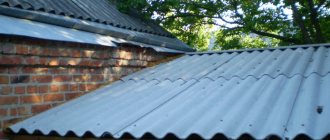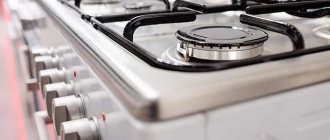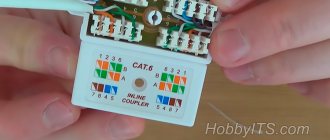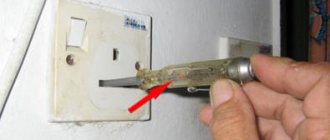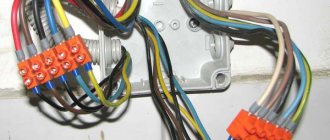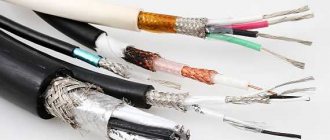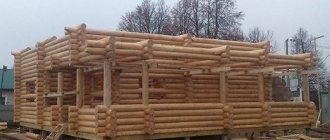Transition resistances
Transitional
are called
resistances
in places where current passes from one contact surface to another through the areas of their actual contact
.
In such a contact connection, a certain amount of heat is released per unit time, proportional to the square of the current and the resistance of the areas of actual contact.
The amount of heat generated can be so significant that the transition resistances become very hot. Consequently, if heated contacts come into contact with flammable materials, they may ignite, and contact of these places with explosive concentrations of flammable dust, gases and vapors of flammable liquids will cause an explosion.
To increase the areas of actual contact between the contacts, it is necessary to increase their compression forces by using elastic contacts or special steel springs.
To remove heat from points of contact and dissipate it into the environment, contacts with sufficient mass and cooling surface are required.
Thus, to ensure safe working conditions in existing electrical installations
a set of measures should be provided that are implemented at all stages - before the start, during the implementation and at the completion of the work. Activities mean the organization of certain actions in electrical installations (registration of work, appointment of those responsible, preparation of the work site, conducting briefings, etc.), as well as specific manipulations with electrical installation devices (switching, checking the presence or absence of extinguishing in live parts, installation of protective grounding and others). In addition, it is worth taking into account local conditions and applications of electrical installations.
Considered causes of fires
are relevant. Today, a person cannot do without machines, installations and computers. Every year, as practice shows, the use of electrical installations is increasing, and the sooner measures to prevent fires are developed and taken, the safer the future awaits us.
How to seal grooves in a wall with electrical wiring
To decide what is better to seal the grooves after laying the wiring, you need to familiarize yourself with the features of working in walls made of different materials. To seal the holes, you need a spray gun, a tank for mixing mortar, a trowel, a brush and a spatula.
Concrete
Before you start sealing the grooves, you need to generously moisten the hole itself and the area around it with clean water using the following working equipment:
- a piece of foam rubber or sponge;
- spray;
- wide brush with synthetic bristles.
The trenches are first primed and then sealed with a building mixture. It is applied using a spatula with wide cross strokes. After the substance has hardened, the excess is removed with an iron spatula. Movements should be stroking and smooth. After complete drying, the surface is puttied.
Brick
Carrying out work in brick walls is accompanied by a large amount of dust. Before you start sealing the grooves, you need to remove dust and treat the working surface with clean water.
It is recommended to seal the furrows with alabaster or gypsum mortar. If the groove is deep, it is acceptable to use small pieces of stones soaked in mortar. Next, the remaining voids are carefully filled with mortar using a trowel.
Monolithic wall
The work in this case is similar to work in a wall made of concrete or aerated concrete. The recess is filled with viscous putty. The solution fills the cavity as tightly as possible.
Fire protection measures
Various protective measures should be taken to keep the wiring in good condition, for example, laying it under plaster rather than under flammable building materials. As for shields, it is better to choose them from metal or non-flammable plastic - this will serve as protection against the spread of fire. We described in detail how to choose an electrical panel in a separate article.
It is also important to inspect the electrical wiring at least once a year: look at all wire connections in sockets, switches, junction boxes and in the electrical panel itself. Timely detection of poor contact and melted wires is one of the effective ways to protect against fire
If the wiring is old, be sure to replace it with a new one during the next repair. Cracked insulation, old sockets designed for a lower current load, plugs in the panel. All this can lead to a fire at any moment. If it is not yet possible to spend money on replacing the wiring in the apartment, be sure to install automatic circuit breakers and RCDs in the panel. They will save you from a fire at the right time. It is also advisable to install a 100 or 300 mA fire protection RCD at the input in wooden houses as an additional measure of protection.
The fire protection RCD is described in detail in the video:
In addition to all this, it is important to know and under no circumstances repeat typical mistakes when installing electrical wiring, which we wrote about separately. For example, poorly made twisting can cause a short circuit and further fire in the electrical wiring.
Therefore, there is no need to do twists at all.
And of course, if the apartment smells of burnt wiring, and you yourself are not able to find and fix the problem, be sure to call an electrician, having first turned off the circuit breakers in the panel.
What electrical faults can lead to a fire?
September 25, 2017
Usually, after a fire, the first step is to find out who is responsible for such an incident. Accurate information about which electrical wiring faults can lead to a fire will give rise to a claim for damages. Today we will look at what contributes to inflammation and how to protect against its consequences.
Causes of fire
Only strict adherence to safety measures will protect consumers from the threat of fire. Another potential threat in such a situation is electric shock. There are several main causes of inflammation.
technical issues
The connection points and the general condition of the wiring require the closest attention. Constant monitoring is necessary for the installation sites of protection devices and supply lines of cables - distribution and main boards. These network components should be checked for normal operating condition. Also, in case of emergency situations, it is necessary to provide for the installation of backup protection.
Connections are especially dangerous if there is poor contact, which can easily cause a fire. Residual current devices in any room, and especially in areas with high humidity, will guarantee reliability and safety during operation.
Wrong choice of circuit breaker
Instant operation in case of overload or short circuit is the main function of the machine. Therefore, the correspondence of the switch rating to the wiring cross-section remains the main criterion at the stage of selecting the device. If such a requirement is neglected, the operation may not take place or may occur too late.
Errors during operation
Any device has a permissible load limit. Connecting different extension cords or several powerful consumers into one outlet can cause a fire. A potential hazard comes from damaged cords or plugs. At the first signs of heating anywhere in the wiring or device, it is necessary to check the condition of the contact connections.
Problems with the lighting group
Various reasons can negatively affect lighting elements. It is important to take measures to prevent moisture on switches and splashes on incandescent lamps.
Connection of copper and aluminum conductors
Among technical problems, a violation of this kind often occurs. There is a risk of fire even when connecting neutral wires using a special strip. The use of brass as a material for such strips is excluded due to their gradual oxidation. In combination with aluminum, this increases heating processes and the likelihood of fire.
In a situation where such a connection is placed inside a plastic shield, the consequences look even more dire. It is impossible to do without connecting copper and aluminum, but this must be done either using special sleeves or using terminal boxes.
Poor quality sockets
The plug of the device must fit tightly into the socket and be securely fixed in it. If sparks occur or the plug temperature increases, replace the outlet immediately. You should not try to save money and buy cheap models. The plastic in them gets very hot, and the contact connections are made without compression springs.
Outdated wiring
In older buildings, switchboards are located on the staircases. Due to significant neglect, the level of security in such places is practically zero.
The wiring has not been changed for many decades, which means destruction of the insulation and complete unusability of the current conductors.
The likelihood of short circuits increases significantly, which is caused by the use of a much larger number of electrical appliances in apartments and increased load parameters on aluminum wires.
Low-quality electrical goods
On the market, unfortunately, cases of sales of products that are not able to cope with the load specified by the manufacturer have become more frequent. Consumers are faced with the need to replace newly installed cables and wires due to cracks and shedding of insulation.
Main fire protection measures
One of the basic rules is to lay the wiring not under flammable materials, but under a layer of plaster. Shields made of non-flammable plastic and metal have proven themselves in practice.
It is important to consider the need for an annual audit of the electrical network. It is recommended to carefully inspect the electrical panel and distribution box, all switches and contacts in sockets. Identifying defects in joints and areas with signs of melting remains one of the reliable ways to combat fire.
Troubles can happen at any moment due to plugs that are unsuitable for the load, a bad socket or damaged insulation.
Wiring that has served for a certain period of time should be replaced during the first renovation of the premises. Before that, spare no expense on installing RCDs and automatic machines.
In wooden buildings, the installation of a 100 and 300 mA fire safety device at the input is used as additional protection.
Another important point is the absence of twists, which, if performed poorly, become a factor in the occurrence of a short circuit.
If there are signs of burning in the room and you are unsure of your ability to cope with problems, you should turn off the machines and wait for a professional electrician to arrive.
What to do in case of a wiring fire?
If the apartment smells of burnt wiring, you notice smoke or an open fire in places where wires run or connect, or on electrical appliances that are turned on, you must take the following measures:
- Turn off the electricity, preferably at the input circuit breaker, in order to ensure a simultaneous break in both phase and zero. Without this, there is a high probability of electric shock in case of fire.
- If possible, protect the source of the fire or localize the fire. Under no circumstances should you touch hot elements to prevent burns.
- If there is a fire, begin to extinguish it.
If for some reason the operating conditions of the electrical wiring do not allow it to be de-energized, then the wiring must be extinguished using special means that do not conduct electric current.
How and with what to extinguish a burning wiring?
To extinguish fires on elements or sections of the electrical network that are energized, it is strictly prohibited to use water. Since if it comes into contact with a person, there is a risk of electric shock. Therefore, to extinguish fires in electrical installations defined by the classification in paragraph 1 of GOST 27331-87, only fire extinguishers are used that use aerosol, carbon dioxide, or powder as extinguishing material.
Figure 4: extinguishing electrical installations
But they also make it possible to fight fires only in devices up to 1 kV. And all electrical installations over 1 kV must first be de-energized.
Protection measures
It is much easier to prevent a wiring fire in an apartment than to try to recover from the consequences of a fire. Therefore, to prevent wiring fires, certain safety precautions should be observed:
- At the stage of installation or replacement of electrical wiring, it is necessary to provide a margin for the cable cross-section. This will allow you to increase power if you connect any new device without the risk of fire.
- Ensure that wires are insulated from flammable materials using non-flammable gaskets. For example, on wooden walls it is important to use a special corrugated pipe, textolite strip, asbestos plates and other non-combustible materials. A metal strip can only be used if it is grounded through an RCD, since in the event of a fire in the wiring, potential will transfer to the metal.
- When replacing wiring, you should use a copper cable specifically designed for domestic premises. Despite its high cost compared to aluminum wiring, it is much more reliable. And modern insulating materials do not support combustion, which makes it impossible for such wiring to catch fire.
- Do not connect wires inside walls. Such components cannot be detected until a fire occurs. Therefore, all conductors from the box to the consumer, switch or socket must be solid. And at the connection points they must be connected with factory clamps, avoiding twists.
- If there is a connection between aluminum and copper conductors in the house, such a point should be fixed using a brass sleeve or a special terminal clamp. Even the use of a brass gasket and tightening with a bolt does not provide a 100% guarantee, since the gasket is destroyed and oxidized over time due to the flow of electric current. Figure 2: Wire Connection
- Do not use shields, cabinets or boxes made of flammable materials. Since in the event of a fire in the same electrical panel, the housing itself will support the combustion. Which will lead to the spread of fire to adjacent elements of the building. If metal distribution panels are used, the fire will not spread beyond its boundaries.
- Use short circuit protection both between cable cores and to ground. It is necessary to select an RCD in such a way that it allows you to de-energize the network in the event of a fault in the wiring or devices, when connecting a load that is too large for wiring, and in other emergency situations. Figure 3: Connecting machines
- Refuse to use faulty devices - if you notice damage to the insulation, unusual noise and other signs, take it for repair. The operation of such devices not only threatens their breakdown, but can also lead to a fire in the wiring.
- When repairing equipment or any elements of the electrical network, turn off the power to the room. Since the cause of a fire is often an artificial short circuit made by a careless repairman during work.
- When leaving home, be sure to turn off the power to each device whose operation is not necessary in your absence. Since the cause of a short circuit and further fire in the wiring can be an unloaded device. And if you are away from the apartment for a long time, it is better to turn off the input machine.
It should be noted that the best way to prevent a fire is a fire alarm. Especially for wooden houses or rooms with flammable finishes. Since it will notify about burning wiring even before the critical spread of the flame. Despite the additional costs, this solution will ensure fire safety for your home.
Conclusion
The causes of electrical fires are associated with faulty condition of electrical wiring, electrical equipment, and its improper operation.
To prevent fire, you should repair electrical wiring, sockets, switches, and use only serviceable devices.
It is prohibited to place the equipment near flammable objects, surfaces, or substances. The premises must have primary fire extinguishing means.
This is interesting: The keys of the pass-through switches are in different positions: let’s understand it thoroughly
Instructions for finding the break point
If a malfunction is detected, it is necessary to immediately take measures to determine the cause of the damage and search for the approximate location of the electrical network defect.
First of all, you need to check which rooms have problems with the supply of electrical current.
Melted switches or sockets indicate that damage to the wiring occurred in the adjacent sections of the electrical network
Then you should find out whether the cable break affected lighting fixtures or sockets by checking them with a tester. Depending on the answers to the last question, you should follow the instructions below.
In this case, the malfunction may be caused by a faulty phase or neutral cable.
Broken phase wire
First of all, you need to determine which machine the damaged socket is connected to. Having identified the power source to which the faulty cable is connected, it is necessary to turn off the electricity and disconnect all wires from the panel: “zero”, “phase”, “ground” (if any).
In order to find the power source of the outlet, you need to switch the machine, while simultaneously checking with the indicator the presence or absence of a phase
Then you need to arm yourself with a multimeter, with which you should sequentially check all connections adjacent to the damaged object, starting from the cable in the panel.
In this way, you can identify the affected area: usually between two sockets there are two, and in the presence of “ground”, three wires. If in this area it is possible to identify only one vein (for example, a zero), we can safely assume that the break is located here.
Distribution boxes are often inaccessible because they are hidden under a layer of finishing materials. If you have access to such devices, it is advisable to open them, since damage to the cores often occurs in them.
If no malfunctions are found, you should check the non-functioning wires with an indicator, starting with the twists, and also inspect the terminal block and disassembled twists.
A wiring option is possible that does not require installation of a junction box. In this case, the cables run unhindered from one outlet to another, with two wires entering each outlet box, making up 4 cores. In this case, to identify the defect, it is necessary to remove the devices located at the beginning and end of the faulty section, and then examine all the wires with a multimeter.
Damage to the neutral wire
The search for a broken neutral wire is practically no different from the work on detecting a broken “phase”, but it has certain features.
You can find out about a break in the neutral wire at the contacts of the socket by bringing an indicator screwdriver to this place: it will glow in the “phase”, but will show the absence of a “zero”. In this case, it is useless to use a multimeter to check the voltage, since this device will show an arbitrary value from 0 to 220 V.
It is important to observe strict safety precautions: due to the existing phase, there is still a danger of electric shock even if the socket is not working.
It is quite difficult to understand the intricacy of wires placed inside the wall. To identify a faulty cable, it is often necessary to check the integrity of each network element
If a three-core cable is used to distribute electricity, a “grounding” conductor can be used as a last resort to transmit “zero”. However, in this case, the “ground” function will be absent from the socket: this is generally undesirable and unacceptable if we are talking about high-power household appliances, for example, a washing machine.
Main reasons
An electrical fire can occur in the following situations:
- Short circuit. In this case, the temperature in the damaged area increases several times, melting the electrical wiring strands. Occurs due to breakdown of the insulating material (mechanical damage, microcracks, increased voltage, old electrical wiring).
- Network overload current. It is typical when connecting electrical equipment of increased power, the appearance of large leakage currents, and an increase in temperature in certain areas. These reasons also lead to overheating and subsequent fire.
- Often electrical wiring burns at the junction of current-carrying conductors. As a result of weakening or oxidation of the contact, the contact resistance of the electrical wiring sharply increases, which entails overheating and subsequent fire.
The most common cause of electrical fire is a faulty or damaged power cord for electrical appliances. If this happens, the first thing you need to do is disconnect the device from the mains, cover the fire area with a rag and put out the fire. Most apartments have flower pots, the soil from which is perfect for putting out flames.
This is interesting: What kind of introductory machines should there be after replacing the riser
Method 2. Visual inspection of the wall
Behind the loud name lies a banal examination of the wall with the naked eye. This method is based on the fact that during the organization of hidden wiring, grooves
, into which the cable is later laid. Of course, after the work is carried out, the grooves are carefully masked, but with an interested inspection you can easily find them. So, what needs to be done in order to find an electrical wire laid in the wall in this way?
- tear off wallpaper or any other material that covers the concrete base;
- examine the wall, trying to find traces of the created grooves;
- as a rule, they stand out in a whiter color, and tactile contact with them is characterized by increased roughness.
This is what typical groove marks look like. I think you can find them without difficulty.
Elimination of short circuit consequences
If the search for the short circuit was successful, then it’s time to exhale and start eliminating it. What to do next depends on the extent of the damage to the electrical wiring. Regardless of the situation, before starting any repair work, you should definitely turn off the power to the apartment and make sure there is no voltage.
It is necessary to assess how much the cable insulation was damaged at the time of the short circuit. If there are swelling, darkening or melting, the wire must be replaced. If possible, it is necessary to assess its condition along its entire length.
Connecting wires in the distribution box using terminal blocks
If the wire covering is in order, then the immediate location of the short circuit is removed. The surviving ends of the current-carrying conductors are stripped and connected using Wago terminal blocks, welding, soldering or crimping. In low-current circuits, you can use regular fast twisting at your own risk. However, the PUE (7th edition, clause 2.1.21) does not provide for and does not approve of this method of connecting cables.
Logical method for finding hidden wiring
Installation of home electrical wiring is carried out strictly in two locations: vertical and horizontal arrangement. That is, the cable in the wall is located either perpendicular or parallel to the floor. Therefore, based on logical thinking, we can assume:
- Above light switches and sockets, the cable should go up. Therefore, you should not drill or drive nails over switches and sockets;
- In most cases, the main cable line runs in the wall at an approximate distance of no more than 15 centimeters from the ceiling and floor. Therefore, construction and installation work in this area cannot be carried out.
These are logical guesses and a visual representation of the approximate location of electrical wiring in the wall. You should not trust this method 100 percent.
What to do if the wiring in the apartment catches fire?
Electricity makes human life more comfortable and convenient. At the same time, it is a source of increased danger, causing more than half of the fires occurring in the country.
As a result, people die, expensive property is destroyed, and residential buildings and commercial structures become unusable. When purchasing real estate, its owners cannot know about the condition of the wiring installed in it and the purchased household appliances.
Knowing what to do if the wiring catches fire, you can quickly and without serious consequences avoid an emergency situation.
How not to extinguish live wiring
Fired wiring cannot be extinguished with water or any liquids based on it.
If the wiring in an apartment catches fire, you need to make the right decision regarding the choice of means to extinguish the flame. Rash actions can only aggravate an already difficult situation.
The use of the following means to extinguish live wiring is strictly contraindicated:
- Water and any solutions based on it. Such liquids are excellent conductors of electricity. You can get an electric shock immediately when pouring water. Then the situation only becomes more complicated, as the liquid spreads across the floors, turning the apartment into a high-risk zone.
- Factory-made and home-made alcoholic drinks. When heated, they catch fire, a pungent odor can cause poisoning, and carbon dioxide can cause loss of consciousness.
- Food products (vinegar, sauces, broths). Firstly, they contain water. Secondly, when they are heated, preservatives are released into the air, creating steam and smoke, which impairs visibility.
- Synthetic fabrics. When exposed to fire, they melt, burst into flames, and emit large amounts of toxic smoke. Such materials can ignite surrounding objects with a low ignition temperature.
The best means of fighting fire (in the absence of fire extinguishers) are products made of leather, fur and thick tarpaulin. These materials are non-flammable and airtight, which is the main condition for fighting fire. If the wiring burned out, but everything else survived, damaged clothes are a trifle.
What to do if you can’t put out the fire
If a fire occurs, all doors and windows must be tightly closed to prevent the fire from spreading.
Apartments filled with wooden and plastic products can burn down in a matter of minutes. But the main danger to human life is not fire, but smoke. This must be taken into account when deciding on the course of action in a critical situation.
If the fire cannot be extinguished, the following measures are recommended:
- Close all windows and interior doors tightly and leave the home, taking your phone, documents and valuables with you. In an enclosed space, the fire moves slowly. There is a chance that it will not catch fire before firefighters arrive.
- If the front door is blocked by fire or smoke, lock yourself in the bathroom. After this, wet the towels and plug the cracks with them. Then water the door leaf to prevent it from igniting and burning through.
- When there is a blockage in the back room, you need to use the window to breathe, call for help or go to the fire escape, which will be a great success.
If all of the above methods turn out to be unavailable, you need to lie on the floor by the window, breathe through natural fabric and wait for salvation. You should not try to break through the fire and smoke to the exit. The heat and poisonous gases can cause you to instantly lose consciousness and burn alive.
Wiring Finders
Below are several types of devices that the market currently offers.
"Search".
The first device is called “Search” and it looks like this.
This device uses the electrostatic principle of detecting hidden wiring.
It has 4 sensitivity modes and is capable of detecting a cable at a depth of up to 7 cm. Light and sound indications are used for notification.
It has a number of additional functions and is very easy to use - select mode (the 4th mode is used to search for wiring) and move the device along the wall.
Please note that certain factors may affect its operation (presence of metal objects, high humidity of the wall).
In general, “Search” is a completely acceptable and inexpensive option for detecting wiring, but it does not apply to professional devices.
A large number of analogues of such a device are produced - the same “Woodpecker”, SPO and a number of others.
MAG-2.
The second device, MAG-2, looks like this.
Actions in case of electrical fire
Electricity is an integral part of every person’s life, which makes life easier and more comfortable. However, if certain rules for using electricity are not followed or working with faulty electrical appliances can lead to property damage or pose a threat to human life and health. For example, many people live in houses that were built several decades ago, and the electrical wiring of the premises remains from those times. Of course, the condition of such electrical wiring leaves much to be desired, and if the wires are not replaced in time, a fire may occur, which in the worst case may develop into a fire.
How can you extinguish live wiring?
It happens that when an electrical wiring catches fire, there is no person nearby and it is impossible to quickly put out the flames. In these cases, in order to prevent a fire, it is necessary to act quickly and it is not always possible to run to the electrical panel to turn off the power to the house. A fire in its initial stages can be extinguished using earth and sand. But for such emergencies, it is better to have a special fire extinguisher in the house. Not all types of this device can be used to extinguish live appliances and electrical wiring. Therefore, before purchasing, you need to figure out which fire extinguisher can extinguish electrical wiring.
The best option is a carbon dioxide fire extinguisher, which can be used to extinguish fires in electrical installations under voltage up to 10,000 V. The extinguishing agent has a low temperature and is supplied under high pressure. Due to this, it is possible not only to eliminate the fire, but also to cool the smoldering sections of the electrical wiring. The main disadvantage of this device is that the vapors released during evaporation are harmful to human health. Therefore, it is prohibited to use a carbon dioxide fire extinguisher to extinguish fires in unventilated areas.
For apartments and private houses where the network voltage does not exceed 380 V, a good option would be to purchase a powder fire extinguisher, which can be used to extinguish electrical installations under voltage up to 1000 V. The powder agent quickly eliminates the fire by isolating the source of the flame from oxygen.
If it is possible to turn off the power, you can use water and foam fire extinguishers. Otherwise, you cannot extinguish electrical wiring with such means, because a person can be electrocuted. When extinguishing a fire, a distance of 1 meter must be maintained.
Prevention measures
If the electrical installation rules were followed when installing electrical wiring, then proper handling of electrical appliances minimizes the risk of wire fires. However, you cannot be 100% sure on this issue, and to prevent possible problems it is better to follow the recommendations described below.
You cannot use many tees and extension cords; it is advisable to lay the cord from them along the walls so that people do not step on it or heavy objects are placed on it. You need to know that the maximum current for a single-phase socket is 16 A. If this threshold is exceeded, the current protection may not work and the socket will become dangerous.
It is necessary to inspect junction boxes several times a year. The contacts are checked for the strength of the connection, and the oxidation layer, if one has formed, is cleaned.
It is necessary to monitor the condition of the sockets and periodically check the reliability of the clamping contacts. Worn-out products may begin to spark, which can subsequently cause a fire and develop into a fire.
Heating electrical appliances that are turned on must be constantly monitored. If you need to leave the house for a long time, you can turn off the electricity supply at the electrical panel.
Everything is gone: there are no beams
So, you've found the perfect place for your TV in your home. You've read all our tips for finding beams in walls, and now it's time to get to work. However, imagine that you have been looking for beams in the wall for 20 minutes, but they are not there. Or, let’s say, they are there, but not where they are needed. Well, this problem can be dealt with too. There are several solutions.
Electric outlet. If the inhomogeneity detector did not help, then you can proceed as follows. On the desired wall, locate the outlet or air conditioning grille. As a rule, all sockets are attached to beams (with the exception of rare cases when an external socket is placed on a finished wall). Having selected the required socket, insert a small flat tool into the gap between the socket box and the wall panel (you must first remove the socket frame). To the right or left you should come across a wooden beam. When the beam is found, step back 40 cm from it in the direction you need. Follow this step to the intended installation location of the TV bracket. Then, using a sharp tool (nail, screwdriver), make a small hole to check if there is a beam.
We drill the bracket. If you managed to find the bars in the wall, but the finished holes in the bracket do not match them, then solving this problem is quite simple: make several additional holes. To do this you will need a good metal drill and a powerful drill. If you have a quality tool at hand, the process will take just a few minutes.
Alternative solution. What to do if not a single beam could be found in the right place? This is where a metal anchor for hollow structures (Molly bolt) comes to the rescue. Today in a specialized store you can find very reliable anchors that will easily support a 55-inch TV. Attaching the bracket to a plasterboard wall using such bolts is a pretty good solution. Professional installers often do just that, but you need to be sure of the reliability of the wall and the quality of the anchors. If you don’t have enough experience, the TV panel may fall along with the bracket, so you shouldn’t rely on chance - it’s better to invite a specialist.
Overloads as an emergency mode of operation of electrical equipment
Overload
This is called
an emergency mode
in which currents arise in the conductors of electrical networks, machines and devices that for a long time exceed the values allowed by the standards.
One of the types of transformation of electrical energy is its conversion into heat. Electric current in the conductors of electrical networks, machines and devices releases heat, which is dissipated in the surrounding space. Conductors can reach dangerous temperatures. Thus, for bare copper, aluminum and steel wires of overhead lines, the maximum permissible temperature should not exceed 70°C. This is explained by the fact that with increasing temperature, oxidative processes intensify and oxides with high resistance are formed on the wires (especially in contact connections); The contact resistance increases, and, consequently, the heat generated in it. As the connection temperature increases, oxidation increases, and this can lead to complete destruction of the wire contact.
The cause of
overload may be caused by incorrect calculation of conductors during design. If the cross-section of the conductors is underestimated, then when all the provided electrical receivers are turned on, an overload occurs. Overload may occur due to the additional inclusion of electrical receivers for which the network conductors are not designed.
To avoid overload or its consequences, during design it is necessary to correctly select the cross-sections of network conductors according to the permissible current, as well as electric motors and control devices.
During the operation of electrical networks, you cannot turn on additional electrical receivers if the network is not designed for this.
The load has increased
Previously, the house had a TV, a refrigerator, and sometimes an iron, a vacuum cleaner or a washing machine would be turned on. All these old household appliances consumed quite a lot of energy; residents of high-rise buildings knew that if you turn on the iron and vacuum cleaner at the same time, it would blow out the plugs.
New household appliances have much less power, they consume less energy, but there is a lot of it. Walk through your home and count everything that is plugged in all the time and everything that you plug in as needed.
In total, it turns out that the load has increased, not decreased. But the wires are still the same!
What to do if there is a wiring fire
Statistics show that people often do not know the rules of conduct when an electrical cable burns. The algorithm of actions in such a situation is as follows:
- De-energize the room. It is advisable to turn off the input machine.
- Put out the fire. If necessary, you can call a neighbor for help.
- When localizing the fire, do not touch surfaces. They're hot.
- The fire extinguishing agents used must not conduct current.
- If you realize that you cannot control the fire, call the fire department.
First actions
The causes of electrical panel fires in the entrances of microdistricts are often unknown. Despite this, the liquidation procedure has the following sequence:
- Do not panic. Do everything quickly, but calmly.
- Unscrew the plugs or turn off the machine.
- Evacuate women and children.
- Call the fire department.
- Eliminate the air supply. Close the windows and doors.
- Wet a towel and cover your nose with it.
- Find the source of the fire. Use available means to eliminate it (blanket, soil from flowerpots).
- If there is a great risk to your life, leave the premises. Wait for the rescuers. They will localize the fire and find out who is to blame.
- After extinguishing the fire, call an insurance representative and demand payment of compensation.
How to stew
Localizing a wiring fire can be done in four ways:
- Turn off the power to the burning network and use available means.
- Use fire extinguishers that correspond to the fire class. This option is more suitable for enterprises.
- Extinguishing non-de-energized wiring can only be done with sand or earth. The use of other improvised means is life-threatening.
- To put out fires in winter, you can use a snowball. A well-aimed hit at the source of fire will short-circuit the wiring and the machine will turn off.
In order to prevent network overload or short circuit, it is necessary to make simple calculations. If the wiring in the electrical panel smells, in order to avoid a fire, you need to take the device and inspect it. There is a video that describes in detail how to do this. If you are not confident in your own abilities, call an electrician.
How to fix a switch: types of devices
If you find out that your switch is not working and decide to fix it, then the device must be disassembled. Before this can be done, the power to the network is completely cut off. To do this, turn off the power at the switchboard automatically, and then check the voltage status at the output.
If you were unable to de-energize the line you needed, then it is best to disconnect the entire apartment from power. Only after this can you begin repairing the switch. But that is not all. Before removing the switch, it is necessary to determine its type.
What could the switch be:
- Single-key;
- Two-key;
- Pass-through, or three-key;
- Spinning;
- Dimmer – switch;
- Touch switch.
Today there is a wide variety of switch models on the market, but most users have conventional key devices.
This is interesting: Scheme of a diode bridge with two diodes and two capacitors: illustrating in general terms
Hazard Prevention Measures
The first and most effective way is to install special protective devices in the shield. For example, an RCD will help prevent current leakage in the apartment in time, a circuit breaker will help prevent short circuits and overvoltage, and a voltage control relay will prevent the occurrence of two phases in the socket, as well as overvoltage. Please note that you can only use an RCD if you have grounding, as required by the PUE in Chapter 1.7, namely in paragraph 1.7.80.
The next thing you need to take care of is to inspect the electrical wiring at least once a year (or better yet, every six months). This will allow timely detection of poor contact, cable damage or overheating of current-carrying conductors. Here you can also include an assessment of the condition of the old wiring. You need to be aware of when it is better to replace the entire home electrical system. Don't forget about the main signs of an electrical problem - crackling noises, sparking sockets, a burning smell. If any of these signs show themselves, you need to immediately start looking for a breakdown.
And lastly, follow safety precautions during repairs. Before hanging the TV on the wall, determine where the hidden wiring is located so that you don’t accidentally get into it when drilling. We talked about how to find a wire in a wall in the corresponding article. In addition, do not forget that you need to connect aluminum to copper only using special terminal blocks, and electrical installations are only allowed during a complete power outage.
So we looked at possible electrical wiring faults in an apartment and a private house. We hope the article was useful and interesting for you!
Tags: machine, beat, sconce, input, input machine, view, harm, choice, switch, house, , clamp, grounding, sign, insulation, cable, like, , installation, power, voltage, overvoltage, potential, touch, wire, project, laying, start, , work, calculation, relay, repair, socket, row, network, twist, connection, resistance, means, ten, type, current, installation, shield, electricity, electrical panel, effect
The TV seems to be hanging crookedly
All work is completed: holes are drilled, bolts are tightened, cables are pulled, the TV is hung. And now you are looking at a brand new TV panel on the wall, but something is wrong... The TV is hanging crookedly! So what should I do? Drill again? Scream or cry? Nothing out of this. There is almost always a way to level the TV on the bracket. Keep in mind that the TV is not always to blame: crooked ceilings, floors and walls create the effect of a crookedly hung TV.
A small building level is always useful on the farm
Level the TV with your hands. Seriously. This often helps. You just need to grab the panel on the sides and tilt it slightly in the desired direction. It all depends on how tightly the bolts are tightened. If they are overtightened, then there is little chance. Be that as it may, you need to act carefully - you should not hang onto the TV with full force (you may fall).
Loosen, move, tighten. Remove the TV, loosen the bolts on the mating part that is attached to the TV itself, and move it up and down. After tightening the bolts back, hang the TV and see what happens. If this does not help, you will have to remove the TV panel again and do the same with the base on the wall.
Improvisation. If all else fails, it’s time to get smart. For example, you can drill out the bracket holes a little so that there is some play for tilting to one side. Just don't worry about making huge holes and ruining the bracket. If by chance the hole turns out to be too large, you can buy a washer and place it under it.
Cracks in the outer wall of a panel house, how to strengthen them?
Good afternoon I ask for advice, the house is 1986, series 90-05, the outer wall (end apartment) has a whole web of cracks, how critical is all this? What can be treated to prevent excess moisture from the street, the seams were smeared in late autumn, we haven’t tested them yet, I don’t want surprises to appear in the spring. What material do you recommend using? What is the operating procedure?
Avlevani, what is this? plaster on the facade of the house?
Avlevani wrote: avoid excess moisture from the street,
Where do such fears come from - were there any complaints from residents?
Gray, room wall
Avlevani, If you want the right advice, also answer this:
Gray wrote: Where did such fears come from - were there any complaints from residents?
Gray, There was a wet spot during a heavy downpour, now I’m starting to renovate this room, I want to at least somehow protect myself. There is no certainty that they missed the target properly from the street, and spring is still far away..
Avlevani, widen the cracks, prime and fill with putty. To be sure, use moisture-resistant cement putty. For extra confidence, putty all walls with cement putties. This is all.
Avlevani wrote: the outer wall (end apartment) has a whole web of cracks, how critical is all this?
Gray wrote: Avlevani, what is this?
Avlevani wrote: Gray, room wall
No photo of the outer wall? How then do we know about the whole web of cracks? Is this from someone’s words or have you seen a whole web of cracks yourself? If you saw it yourself, then why didn’t you take a photo?
Gray wrote: widen the cracks, prime them and fill them with putty. For confidence - moisture resistant
Here's some great advice.
Avlevani wrote: Good afternoon! I ask for advice, the house is 1986, series 90-05, the outer wall (end apartment) has a whole web of cracks, how critical is all this? What can be treated to prevent excess moisture from the street, the seams were smeared in late autumn, we haven’t tested them yet, I don’t want surprises to appear in the spring. What material do you recommend using? What is the operating procedure?
Avlevani, I don't know the brand and type of panels in your house. Indicate what they are made of, whether the panels have insulation. A wet spot may appear due to improper waterproofing of the seams.
Avlevani wrote: the outer wall (end apartment) has a whole web of cracks, how critical is all this?
Gray wrote: Avlevani, what is this?
Avlevani wrote: Gray, room wall
No photo of the outer wall? How then do we know about the whole web of cracks? Is this from someone’s words or have you seen a whole web of cracks yourself? If you saw it yourself, then why didn’t you take a photo?
Gray wrote: widen the cracks, prime them and fill them with putty. For confidence - moisture resistant
ADM05, No cracks are visible from the street, the façade is lined with small tiles. Photo from the side of the apartment, regarding the “web of cracks” I added a photo, the whole wall is covered in such cracks, what could be the origin?
Avlevani wrote: the whole wall has such cracks, what could be the origin?
These cracks are shrinkage, they appear when the plaster dries (shrinks) immediately after its application, and the plaster remains in this form throughout its life. These cracks have nothing to do with getting the walls wet after rain. The reason for your wall getting wet should be looked for on the facade, under the tiles: - where
Avlevani wrote: no cracks are visible, the facade is lined with small tiles.
Gray, it’s just all the other walls without them that’s what’s annoying)
Avlevani, it happens. Do you have any photos of the rest of the walls?
Gray, Opposite side of the same room)
Avlevani, well, those walls are plastered, but these are not. These are solid concrete
Gray, Just a very strange plaster) That’s why doubts arose)
Naturally, because this is not plaster.
This is how the slabs were cast at the factory, and most likely they are made with expanded clay. Processed as usual.
As for leakage at the seams, this can only be eliminated from the outside, with mastic. This is done by the management company, housing office or whoever takes their place. An application is written and all that, this is a standard service for us, it seems even free.
AndyMirror, That’s right, with expanded clay) Thank you!
Good day, dears! In order not to create topics, I’ll ask here. Please help me on the next question. We are considering purchasing an apartment in a 9-storey building. Series 121VL-013/1, as indicated on the website “housing and communal services reform”, year of commissioning 88. One wall in the apartment is an external side wall. It has a couple of vertical, covered cracks. There is also a similar crack on the panel of the upper apartment. There is nothing like this on any other panel from other apartments. We can’t really look inside until we try: tear off the wallpaper and check the wall. But nothing is visible on the wallpaper, no distortion, no tears, no traces of moisture, etc. That's actually what interests you. What could cause such cracks? How problematic are they, what surprises will they bring? Maybe it’s not worth considering this apartment with such defects at all? Thank you!
Nada wrote: Good day, dears! In order not to create topics, I’ll ask here. Please help me on the next question. We are considering purchasing an apartment in a 9-storey building. Series 121VL-013/1, as indicated on the website “housing and communal services reform”, year of commissioning 88. One wall in the apartment is an external side wall. It has a couple of vertical, covered cracks. There is also a similar crack on the panel of the upper apartment. There is nothing like this on any other panel from other apartments. We can’t really look inside until we try: tear off the wallpaper and check the wall. But nothing is visible on the wallpaper, no distortion, no tears, no traces of moisture, etc. That's actually what interests you. What could cause such cracks? How problematic are they, what surprises will they bring? Maybe it’s not worth considering this apartment with such defects at all? Thank you!
Nada, Ask the technicians at the management company about roof leaks and leaks in the basement, during the conversation they will tell you everything, especially for a bottle of beer. Visually, there are no special problems visible, there are and always will be cracks in concrete, this crack is covered and that’s why you see it.
Where to look for a broken wire
If the light in the house flickers, disappears completely, sparks, smoke, the circuit breaker on the panel trips, or there is no current in some or all sockets, you should check whether the circuit breaker has been knocked out or the fuses have blown. If nothing happened to the meter, and everything is fine with your neighbors’ electricity, it means that your power supply circuit has opened.
The cause of the breakdown may be a break, loss of contact at the terminal connections, violation of the insulation protection of the wire and its malfunction. To prevent this from happening, wires from electrical equipment must not be bent, tied, twisted, or crushed with heavy objects.
The wire can be damaged in any area:
- in the conductor adhesion zone,
- in places where wires are connected to the contacts of switches, sockets, electrical panels;
- in the space between these devices and the box.
Method 3. Radio or regular microphone
If you cannot visually find a direct electrical wire located in the wall, you can use a regular radio or microphone. Both options will allow you to easily find the required area.
Radio
- Any receiver tuned to the range of 100-150 kHz is suitable for searching;
- plug in an electrical appliance with high current consumption;
- bring the receiver to the wall and start moving it along in search of the cable;
- a crackling sound or a constant hiss will indicate the location of the electrical wire.
Microphone
- connect the microphone to the tape recorder;
- We carry out the same manipulations as with the receiver;
- If you heard a crackling or hissing sound or any other noise, it means you found what you were looking for.


